Seneca Lake Monster
New Member
Greetings,
Firstly I appreciate any and all professional advice that anyone here can provide. I read another thread on a similar topic a few weeks ago, and the original poster seemed to sustain an adversarial posture despite (and in spite of) the sound recommendations of the professionals on this forum.
When I purchased my home it had a preexisting Flotec laundry tray system into which the basement utility sink drained (into which the previous owner's washing machine in turn, drained). The Flotec drain rises about seven feet until it becomes horizontal and joins the house wastewater line.
My wife and I opted to place our washing machine next to the dryer (farther across the basement) rather than next to the utility sink. This necessitated a new approach to draining the washing machine. A local plumbing company installed a standpipe and drain line that now also drains into the Flotec--except when it doesn't.
Almost always when the washing machine drains the drain water backs up into the utility sink before it eventually drains into the Flotec and/or is pumped away by the Flotec once the float reaches the trigger height for the sump pump. This seems wrong, as I would expect the Flotec, which is at a lower height than the sink basin, simply to fill until the pump runs without backing up into the sink.
I think the cause of this behavior is that the vent pipe for the Flotec has an AAV at the top rather than tying into the house vent stack. The Flotec vent pipe was open to the basement when we purchased the house. The home inspector had noted that it violated code, so the same plumber that put in the washer standpipe added the AAV (rather than tying into the vent stack as one of his colleagues had originally recommended). I suspect that the AAV doesn't allow proper venting (out) of the Flotec when water rushes into the Flotec (where can the air go?). This causes air to try to escape where the power cords enter the top of the basin (hissing sound) and causes the washer drain water to back up into the sink until it can drain/be drained.
I've attached photographs of my washing machine and drain system. Aside from this I've shared videos from my Google Drive that walk through all of what I've said here in more detail including a demonstration of the apparent problem behavior. The videos can be accessed here: https://drive.google.com/drive/folders/1-WFj6MPfyF-Yh2FMpqzIUoX-f6FGt1Ri?usp=sharing. Video Mar 13, 22 22 38-1.mp4 is a walkthrough of the plumbing an apparent problem. Video Mar 13, 22 40 02-1.mp4 is a little more info with another question. Video Mar 13, 22 50 38-1.mp4 is the problem in action. (Photos are here, too.)
My assumption is that proper resolution would be to tie the Flotec vent pipe into the house vent stack. Also, as I noted in the second video, should the small drain hose from the water conditioning system drain into the Flotec drain pipe? It seems to cause Flotec to run even when there is no apparent water flowing in. Could this indicate that the check valve on the Flotec is bad?
Thank you.
Firstly I appreciate any and all professional advice that anyone here can provide. I read another thread on a similar topic a few weeks ago, and the original poster seemed to sustain an adversarial posture despite (and in spite of) the sound recommendations of the professionals on this forum.
When I purchased my home it had a preexisting Flotec laundry tray system into which the basement utility sink drained (into which the previous owner's washing machine in turn, drained). The Flotec drain rises about seven feet until it becomes horizontal and joins the house wastewater line.
My wife and I opted to place our washing machine next to the dryer (farther across the basement) rather than next to the utility sink. This necessitated a new approach to draining the washing machine. A local plumbing company installed a standpipe and drain line that now also drains into the Flotec--except when it doesn't.
Almost always when the washing machine drains the drain water backs up into the utility sink before it eventually drains into the Flotec and/or is pumped away by the Flotec once the float reaches the trigger height for the sump pump. This seems wrong, as I would expect the Flotec, which is at a lower height than the sink basin, simply to fill until the pump runs without backing up into the sink.
I think the cause of this behavior is that the vent pipe for the Flotec has an AAV at the top rather than tying into the house vent stack. The Flotec vent pipe was open to the basement when we purchased the house. The home inspector had noted that it violated code, so the same plumber that put in the washer standpipe added the AAV (rather than tying into the vent stack as one of his colleagues had originally recommended). I suspect that the AAV doesn't allow proper venting (out) of the Flotec when water rushes into the Flotec (where can the air go?). This causes air to try to escape where the power cords enter the top of the basin (hissing sound) and causes the washer drain water to back up into the sink until it can drain/be drained.
I've attached photographs of my washing machine and drain system. Aside from this I've shared videos from my Google Drive that walk through all of what I've said here in more detail including a demonstration of the apparent problem behavior. The videos can be accessed here: https://drive.google.com/drive/folders/1-WFj6MPfyF-Yh2FMpqzIUoX-f6FGt1Ri?usp=sharing. Video Mar 13, 22 22 38-1.mp4 is a walkthrough of the plumbing an apparent problem. Video Mar 13, 22 40 02-1.mp4 is a little more info with another question. Video Mar 13, 22 50 38-1.mp4 is the problem in action. (Photos are here, too.)
My assumption is that proper resolution would be to tie the Flotec vent pipe into the house vent stack. Also, as I noted in the second video, should the small drain hose from the water conditioning system drain into the Flotec drain pipe? It seems to cause Flotec to run even when there is no apparent water flowing in. Could this indicate that the check valve on the Flotec is bad?
Thank you.
Attachments
-
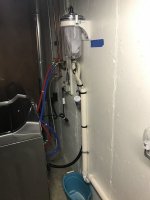 Photo Mar 13, 22 21 00.jpg58.7 KB · Views: 535
Photo Mar 13, 22 21 00.jpg58.7 KB · Views: 535 -
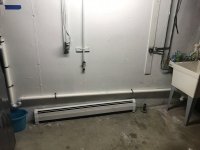 Photo Mar 13, 22 21 06.jpg62.4 KB · Views: 451
Photo Mar 13, 22 21 06.jpg62.4 KB · Views: 451 -
 Photo Mar 13, 22 21 15.jpg56.3 KB · Views: 454
Photo Mar 13, 22 21 15.jpg56.3 KB · Views: 454 -
 Photo Mar 13, 22 21 29.jpg66.9 KB · Views: 516
Photo Mar 13, 22 21 29.jpg66.9 KB · Views: 516 -
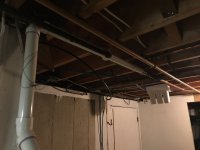 Photo Mar 13, 22 21 40.jpg54.6 KB · Views: 442
Photo Mar 13, 22 21 40.jpg54.6 KB · Views: 442 -
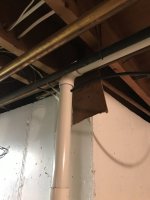 Photo Mar 13, 22 21 44.jpg53.8 KB · Views: 440
Photo Mar 13, 22 21 44.jpg53.8 KB · Views: 440 -
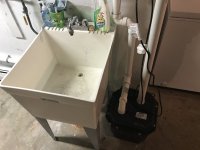 Photo Mar 13, 22 21 56.jpg63.9 KB · Views: 438
Photo Mar 13, 22 21 56.jpg63.9 KB · Views: 438 -
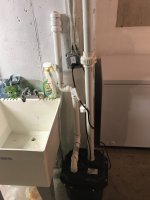 Photo Mar 13, 22 22 01.jpg61.7 KB · Views: 1,626
Photo Mar 13, 22 22 01.jpg61.7 KB · Views: 1,626
